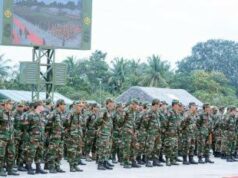Raising of HQ Theatres for Defence of India

Since the Cabinet Committee Security took the decision in principle to raise HQ Theatres for defence of India, all kinds of sense and non sense have emanated from various corners. Some of these are well meaning and need to be debated where many others are pure nonsense and even deliberate red herrings.
Firstly, we must put a stop to the Word THEATRE COMMANDS because it is causing confusion, which at times seems to be deliberate. Rather the nomenclature should be just THEATRE and what are to be raised are HQ Theatres… three, four, five or more as required.
Yes, Jointness is essential for fighting. Army itself is joint force of different Arms and Services. Each Arms/Services have their own tailored units for operations. However for actual fighting most of them together and jointly form what is called a Brigade. Some more join at Division level and a Corps generally has nearly all the varieties possible.
What stands out in this jointness is COMMAND and CONTROL. The General Officer Commanding a Division has full Command authority over all units/formations placed under him and so is the case with the Brigade Commander. Now can this jointness be replicated at unit level? A combined Arms/Services unit can certainly be formed by having say two infantry Company, one artillery battery, one Armoured squadron etc.
However will it work both in peace and war? Training, Specialization, equipping, manning, administration etc of each is so varied that it will be next to impossible for the Commanding Officer to function in a coordinated manner and as one entity. Why not try it out.
After all the smallest fighting unit of the Mauryan Army a PATTI comprised 5 x infantry soldiers, 3 x horse Cavalry soldiers, a Chariot and an elephant (number of soldiers of Chariot Arms and elephant Arms not clear but likely two each).
Now coming back to Theatres, firstly these Theatres will cover a given geographical area. Our highest fighting formations in the Army being a Corps, we need to see, how many of them are required to be placed under each Theatre for proper defence of that Theatre and then some for offensive operations.
Next comes the Air Force who are organized to fight in a different way than the land forces. Here the largest fighting unit is a Squadron but the largest supporting formation is a Wing. So need to evaluate the number of Squadrons needed for offensive, defensive and other types of operations and the bases required in each Theatre, from where they can operate.
With the Navy too coming in the area of a given Theatre, we will have to work out the Naval forces required and the bases from where they will operate.
It is well established that not more than four large size formation plus three to four smaller size formations should be reporting to the next higher formation HQ. So a HQ Theatre should not be having more than four Corps and four Wings and say two naval bases under its direct Command.
Any thing more means confusion and chaos during an intense phase of battle. Thereafter the geographical linear spread and compactness too are also needed to be kept in mind. In our case a Corps Communication Zone is covered by one two States and maximum may be three. This is also an important aspect for logistics, rear area security etc.
Now let’s examine one of the proposals of having three Theatres…Northern, Western and Maritime. The length of the Northern Theatre will be covering nearly 4000km. It will be responsible for defence of around 11 States/UT. There will be four 4 x existing Corps for defence with at least two more HQ Corps raising to cover UP, Bihar, HP and Uttarakhand borders.
In addition there will be two offensive Corps ie minimum total of 8 x Corps HQ. Then from the air force side there will be at least 20 Wing size bases. The Naval component will be operating from bases in West Bengal and Orissa.
The above clearly indicates that all these Corps, Wings and naval bases reporting directly will surely create chaos and nothing else. So it is very clear that there has to be Component Commanders, even more than one for each Service, That means the existing Army and Air Commands have to be there but of course restructured for the new role. Even a Naval Component Commander will have to be there.
Hence all talks of doing away with 17 existing Commands of the three Services is pure red herring and total bunkum. A relook has to be given to size of the Theatre itself and we don’t’ have to copy the Chinese blindly. Instead of having one Northern Theatre, it will be more prudent to have a Northern Western Theatre, a North Eastern Theatre and a South-western Theatre. Even the Maritime Command is just too big and must be divided into two Theatres…South Eastern and South Western.
All the above have been brought out quite well in the book NAVIGATING DANGEROUS WATERS by an Army Officer. Ideal will be five Theatres, each headed by a four star Officer.
Some red herrings are being thrown regarding the three Services Chiefs. That they will be reduced to the level of Director Generals…..again pure bunkum. Unburdened with their operational role, they will actually be able to work as the Chief of Staff to the Supreme Commander, as in the USA system.
Presently this very crucial role has been suffering. They can now devote full time to futuristic planning, budgeting, weapon acquisition and its monitoring, manpower planning, training, Cadre management including pay and allowances, ESM welfare including ECHS and even mundane subjects like Table of Precedence. They can interact more with Parliamentary Defence Committee, National Security Advisory Board, Raksha Mantri, External Affairs and Home Minister both individually and as Chief of Staff Committee.
Even after the raising of five Theatres, another four star Officer will have to be appointed as VCDS to oversee Command and control of Strategic Forces Command, Armed Forces Special Operational Division, Armed Forces Cyber agency and Armed Forces Space Agency (subsequently all these have to become full Commands under senior three star officers.
The Command and Control of the Theatres have to be given either to the CDS or to the Chief of Staff Committee. Unlike the American system it cannot go to the Raksha Mantri for obvious reasons. Even in the USA even when Joint Chief has no direct Command, all orders by the President/Secretary Defence are passed to the Theatre Commanders, through the Joint Chief only.
Thus HQ IDS will act as a HQ for CDS, Chief of Staff Committee and the VCDS. In fact even the Department of Military Affairs needs a C In C level officer as a Secretary DMA to lessen the present extremely heavy load on the CDS.



